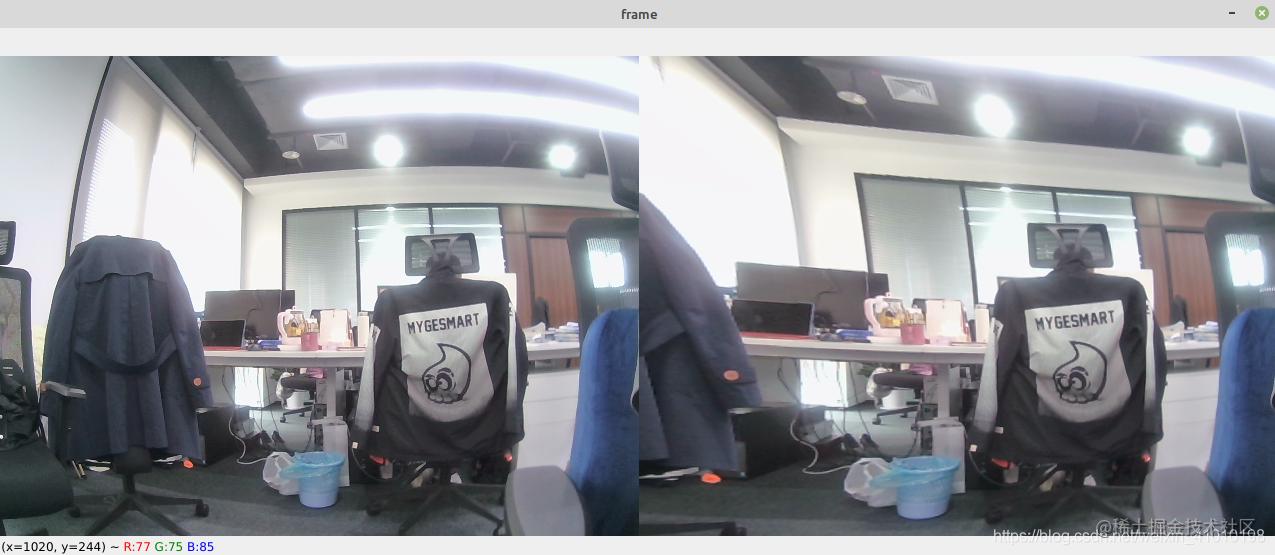python opencv畸变图像矫正
燕阳天 人气:0代码:
__Author__ = "Shliang"
__Email__ = "shliang0603@gmail.com"
import os
import cv2
import numpy as np
from tqdm import tqdm
def undistort(frame):
fx = 685.646752
cx = 649.107905
fy = 676.658033
cy = 338.054431
k1, k2, p1, p2, k3 = -0.363219, 0.093818, 0.006178, -0.003714, 0.0
# 相机坐标系到像素坐标系的转换矩阵
k = np.array([
[fx, 0, cx],
[0, fy, cy],
[0, 0, 1]
])
# 畸变系数
d = np.array([
k1, k2, p1, p2, k3
])
h, w = frame.shape[:2]
mapx, mapy = cv2.initUndistortRectifyMap(k, d, None, k, (w, h), 5)
return cv2.remap(frame, mapx, mapy, cv2.INTER_LINEAR)
# 对摄像头实时视频流做畸变矫正
def distortion_correction_cam():
cap = cv2.VideoCapture(0)
while (cap.isOpened()):
ret, frame = cap.read()
undistort_frame = undistort(frame)
compare = np.hstack((frame, undistort_frame))
cv2.imshow('frame', compare)
if cv2.waitKey(1) & 0xFF == ord('q'):
break
cap.release()
cv2.destroyAllWindows()
# 对目录下的所有图片做畸变矫正,并把畸变矫正后的图片保存下来
def distortion_correction_imgs(input_dir, output_dir):
in_imgs = os.listdir(input_dir)
for img_name in tqdm(in_imgs):
image = cv2.imread(os.path.join(input_dir, img_name))
distroted_img = undistort(image)
cv2.imwrite(os.path.join(output_dir, img_name), distroted_img)
if __name__ == '__main__':
input_dir = "/home/shl/extract_rosbag_data/0324_bags/plycal_calib/root/images"
output_dir = "/home/shl/extract_rosbag_data/0324_bags/plycal_calib/root/distro_imgs"
# distortion_correction_imgs(input_dir, output_dir)
distortion_correction_cam()对图片进行矫正效果:
原图:

矫正后的图片:

采集的摄像头画面矫正效果:

从上面的换面可以看到,左边是未矫正的画面,右边是矫正后的画面:
矫正后的画面会被裁切,明显可以看到画面中的信息是有裁切的,例如左边的椅子已经被裁切掉了- 矫正后的画面和原画面是保持相同的分辨率:
640x480,但是,为什么会看到画面会出现横向的拉伸,这是因为标定相机内参的时候画面的分辨率设置为1280x720=16:9,但是opencv读取摄像头默认的分辨率却是640x480=4:3,两者的比例都不一样,所以肯定会出现拉伸
解决拉伸的方式,就是把读取摄像头的时候,把摄像头的分辨率设置成和标定的时候一样的分辨率,设置为1280x720,下面是如何在opencv读取摄像头的时候设置摄像头分辨率:
# 对摄像头实时视频流做畸变矫正
def distortion_correction_cam():
cap = cv2.VideoCapture(0)
# 获取摄像头读取画面的宽和高
width = cap.get(3)
height = cap.get(4)
fps = cap.get(5)
print(width, height, fps) # 640.0 480.0 30.0
# 在这里把摄像头的分辨率修改为和我们标定时使用的一样的分辨率 1280x720
cap.set(3, 1280)
cap.set(4, 720)
width = cap.get(3)
height = cap.get(4)
print(width, height, fps) # 1280.0 720.0 30.0
while (cap.isOpened()):
ret, frame = cap.read()
print(frame.shape)
undistort_frame = undistort(frame)
compare = np.hstack((frame, undistort_frame))
cv2.imshow('frame', compare)
if cv2.waitKey(1) & 0xFF == ord('q'):
break
cap.release()
cv2.destroyAllWindows()重新设置分辨率后,矫正前后画面对比,可以看到几乎是没有横向或纵向拉伸的!

参考:
https://blog.csdn.net/weixin_40516558/article/details/103494029
https://blog.csdn.net/guaiderzhu1314/article/details/96306509
加载全部内容